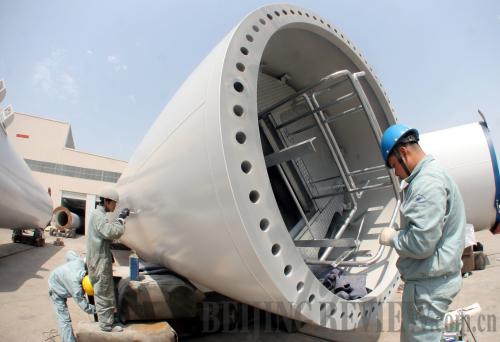|
 |
|
MADE IN CHINA: A wind tower plant in Nantong, east China's Jiangsu Province (CFP) |
The U.S. Commerce Department set tariffs as high as 73 percent on Chinese manufacturers of wind-turbine towers on July 27, adding to trade disputes between the two countries in the renewable energy sector.
The decision came just days after the two countries failed to reach consensus in Geneva during consultations on U.S. anti-dumping and anti-subsidy cases against imports from China. The consultations involved 22 product categories, including steel, coated paper, solar cells and wind-turbine towers, with a total trade value of about $7.3 billion.
Since the beginning of this year, Sino-U.S. trade friction has intensified. July appeared to be a particularly disquieting month for bilateral trade relations.
"Bilateral trade tensions can be attributed to several factors, concerning both Washington's shifting development strategy and the cutthroat competition among Chinese exporters," said Chen Fengying, Director of the Institute of World Economic Studies at the China Institutes of Contemporary International Relations.
Tao Wenzhao, a research fellow on U.S. studies with the Chinese Academy of Social Sciences, added to Chen's remarks by noting that the upcoming U.S. presidential election could be another motivating factor behind the tariffs.
Despite recent trade tensions, analysts say mutual interests between the two countries will ultimately overcome the disputes.
"The high interdependence of Sino-U.S. trade and economic relations has reached a point where neither can do without the other. Any damage to bilateral relations will be minimal," Tao said.
During the latest consultation on the issue, both parties promised to respect the rules set up by the World Trade Organization (WTO) and correct any possible misconduct.
Shifting strategies
"Generally speaking, the key point of the aggravated Sino-U.S. trade friction is related to United States' shifting of its development strategy back to manufacturing in recent years after the 2008 financial crisis," said Tao.
In the last four decades, the United States has devoted itself to building a financial empire to take advantage of the U.S. dollar's dominant status as the world's reserve currency. Meanwhile, it has shifted most of its manufacturing industry to emerging countries like China.
"In the process of economic globalization, labor-intensive industries have lost competitiveness in the United States. Many U.S. jobs in those industries have been outsourced to emerging countries. This conforms to the rules of industrial development but it has also caused job losses in the United States," Tao said.
"It is not that China, as an emerging economy, has stolen jobs from the United States, but rather the United States has deserted them according to its own needs," Tao added.
"Because labor costs are so high in the United States, prices of manufactured goods made in the United States are also very high," said Chen. "It's sometimes joked that Americans wouldn't be able to afford the shoes they made themselves. The United States should acknowledge that emerging countries such as China are better at producing decent products at low prices."
The deindustrialization of the United States has led to the "hollowing out" of U.S. industry, which also brought on high unemployment. In addition, the 2008 financial crisis hit the U.S. economy hard, which was followed by a lackluster recovery.
"The financial crisis has demonstrated the structural problems of the U.S. economy. In a sense, it is a sick economy," Chen said.
| 